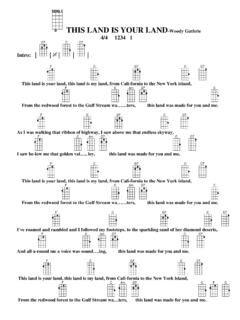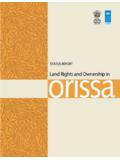Transcription of FAO/Florita Botts / FAO Corruption in the Land Sector
1 # 04 / 2011 TI Working Paper # 04/2010 Table of Contents 1. land , governance and Corruption : the linkages 2. Evidence and consequences 3. Actors and forms of Corruption 4. Measures and responses Corruption in the land Sector Unprecedented pressures on land have been created as new areas are cultivated, taken over by expanding urban centres or are abandoned due to degradation, climate change and conflict. These developments have strained the rules, processes and institutions that determine which land resources are used, by whom, for how long and under what conditions. As evident around the globe, where land governance is deficient, high levels of Corruption often flourish.
2 Weak land governance tends to be characterised by low levels of transparency, accountability and the rule of law. Under such a system, land distribution is unequal, tenure is insecure, and natural resources are poorly managed. As a consequence, social stability, investment, broad-based economic growth and sustainable development are undermined. FAO/Florita Botts / FAO Corruption in the land Sector 2 TI Working Paper # 04/2011 1. land , governance and Corruption : the linkages land governance is fundamentally about understanding power and the political economy of land . It involves the rules, processes and structures through which decisions are made about the use of and control over land , the manner in which the decisions are implemented and enforced, and the way that competing interests in land are managed.
3 1 land governance encompasses different decision-makers, processes and structures, including statutory, customary and religious institutions. When taken together as a system, land governance is ultimately centred on how people use and interact with land . Effective and enforceable land governance provides a necessary framework for development and an important defence against many forms of Corruption . It supports food security and ensures sustainable livelihoods that are essential for people and countries that rely on land as one of their main economic, social and cultural assets. For example, empirical findings from more than 63 countries show that where Corruption in land is less prevalent, it correlates to better development indicators, higher levels of foreign direct investment and increased crop Corruption in land is often the culprit or an offspring of the breakdown of a country s overall governance.
4 Recent findings by TI show that there is a very strong correlation between levels of Corruption in the land Sector and overall public Sector Corruption in a This result suggests that countries confronting pervasive public Sector Corruption are also suffering from a corrupt land Sector a finding which has broad and important implications for ensuring the integrity and effectiveness of initiatives related to natural resource management, including climate mitigation projects and agricultural output 2. Evidence and consequences Corruption in the land Sector can be generally characterised as pervasive and without effective means of control.
5 It can be found in statutory as well as in customary systems. It can vary from small-scale bribes and fraud ( administrative Corruption ), to high-level abuse of government power and political positions ( political Corruption ). Corruption , whether administrative or political, does not favour the establishment of long-term national or local land strategies. When Corruption is present in the land Sector , related actions and decisions are driven by distorted interests and policies that favour the few. Examples of both administrative and political Corruption are described in more detail below. Administrative Corruption Corruption that occurs in public administration and government services is a common feature in the land Sector .
6 It can take the form of small bribes that need to be paid to register property, change or forge titles, acquire land information, process cadastral surveys, and generate favourable land use Such bribery is facilitated by complicated processes and limited information about Corruption in the land Sector 3 TI Working Paper # 04/2011 available services and any applicable fees. For example, a recent World Bank study on land administration in Vietnam found that incomplete and unclear information about administrative procedures was made available to the public.
7 It also noted that the processes for issuing property rights and certificates were complicated and Findings from a Transparency International survey in 2009 suggest that the government bodies which oversee the land Sector are one of the public entities most plagued by service-level bribery. Only the police and judiciary have higher levels of Among the 69 countries surveyed in the study, more than one out of every 10 people who contacted a land authority reported paying a bribe. This figure exceeds reported rates of bribery for schools, health services, tax authorities and public utilities.
8 Similar to other sectors affected by bribery, the findings show that lower income groups are often more The same survey also finds that although 34 per cent of people globally consider Corruption in land authorities to be a very serious problem, the results vary by region. While one out of every two respondents in high income countries said Corruption in land management was a serious problem, nearly four out of every five people in low-income countries shared the same Country-level surveys, of administrative Corruption in the land Sector provide a deeper insight into the problem. In Mexico, a recent study reveals that illegal payments to land authorities ranked among the top 10 services plagued by bribery in the The survey s results show that a bribe has to be paid at least once out of every 10 times that a person solicits a land permit.
9 Another public opinion survey, conducted in Bangladesh, estimates these figures to be much higher. Findings from a national household survey show that land administration ranks among the top three institutions in Bangladesh with the worst rates of bribery ( per cent) based on people who have had contact with the This figure has risen by nearly 20 per cent since the last survey was done in 2007. The cost of bribes paid to land services is also the highest. These illegal payments typically are made to register land , transfer titles, pay property taxes and secure the right to lease government lands.
10 Attempts to document the cost and extent of administrative Corruption in the land Sector have been made by further country-level work. A study in India estimates that US$ 700 million worth of bribes are paid annually by users of the country s land administration According to survey work in Kenya, the average bribe paid by those dealing with government land agencies was US$ 65 in 2011, a figure that had been rising in the last two years but which has since The same survey also finds that Kenya s Ministry of Lands is the fourth most corrupt public administration body in the entire country. Nearly 58 per cent of people who have sought land services from the ministry have been asked to pay a bribe; of those requested to make an illegal payment, more than one-third The enormous prevalence of bribery in the land Sector creates a high informal cost for those trying to register or transfer land .

















